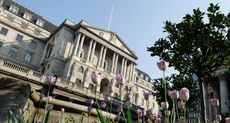Souvenirs of an empire
As a new year of auctions get under way, a treasure trove of memorabilia linked to Britain's colonial past goes under the hammer.


On 21 October 1805, Admiral Lord Nelson sunk to the deck of HMS Victory, mortally wounded. His body, preserved in brandy, was returned to Britain, along with his ship's flags, which were displayed at the Painted Hall in Greenwich ahead of his funeral. When the day came, the battle-scarred "Victory Jack" was to be placed on the coffin by Nelson's sailors before being lowered into the crypt at St Paul's Cathedral.
The Naval Chronicle recorded what actually happened: "These brave fellows, however, desirous of retaining some memorials of their great and favourite commander, had torn off a considerable part of the largest flag, of which most of them obtained a portion."
An "exceptionally large" chunk of that flag has surfaced at nearby Sotheby's, where it is on show until Tuesday. The next day, it is expected to fetch up to £100,000. A far smaller fragment of a Union Jack from the Victory (two were flown) was valued at £70,000 by Christie's just over two years ago. And a complete Jack from the battle (from HMS Spartiate) sold for £384,000 in 2009.
Subscribe to MoneyWeek
Subscribe to MoneyWeek today and get your first six magazine issues absolutely FREE

Sign up to Money Morning
Don't miss the latest investment and personal finances news, market analysis, plus money-saving tips with our free twice-daily newsletter
Don't miss the latest investment and personal finances news, market analysis, plus money-saving tips with our free twice-daily newsletter
From one vice-admiral to another Sir Francis Drake's will is on sale with US dealer Moments in Time. It was signed on 30 May 1588, the day the English fleet first sailed off to tackle the Spanish Armada. "As I am now presently bound unto the seas for special service of her majesty", it begins, he commits on the event of his death his land and property to his second wife, Elizabeth, and his brother, Thomas, "to do in all other things in as large manner as I might do if I were personally present". It has been listed for $1.6m.
When not battling the French and Spanish, British ships explored the globe. Some of the work of the painters who travelled with these vessels goes on sale on 7 February at Bonhams in London. A painting by William John Higgins (1781-1845) of East India Company officials riding choppy waves as they landed at Madras (now Chennai) is valued at up to £18,000.
For larger budgets, there's what Bonhams describes as "a rare and important painting" by Daniel Thomas Egerton, "a significant, yet elusive, British artist". Egerton travelled to Mexico in the 1830s and studied the newly independent nation for several years before he was murdered on the outskirts of Mexico City in 1842. His view of Vera Cruz and Castle of San Juan D'Ulloa is expected to fetch between £200,000 and £300,000.
A record-breaking year for pricey art
"High-priced art has invariably been for the few and not the many," says Melanie Gerlis in the Financial Times. "But this was never more true than in 2017 as the multimillion-dollar end of the business decoupled almost completely from the rest of the trade." Salvator Mundi is, of course, the record-smashing sale that everyone will remember for years to come. The painting, supposedly by Leonardo da Vinci, raked in $450.3m in New York in November, making it the world's most expensive painting by far.
Then there was the $100.5m paid in May for Untitled (1982) by the American graffiti artist Jean-Michel Basquiat, currently fashionable with an exhibition at The Barbican in London. And we shouldn't forget the £48m handed over for a Gustav Klimt in London in March. All in all, "we are predicting that art will comfortably overtake wine as the best-performing asset class this year", Andrew Shirley, author of the Knight Frank luxury index, told The Guardian last month.
You can see why. But in terms of luxury goods, it wasn't just the art world hitting the headlines. Hong Kong saw new auction records set when an oval-shaped 59.6-carat diamond, known as the Pink Star, sold for HK$553m (£57m) in April, while a rare Song Dynasty Ru-ware bowl fetched HK$294.3m (£38m) in October.
In May, meanwhile, the world's most expensive pair of earrings comprising the Apollo Blue and Artemis Pink diamonds sold for CHF 57,118,750 (£44.4m) in Geneva, Switzerland.All in all, 2017 was the year the super-rich returned in force, delighting the big auction houses, Sotheby's and Christie's. Whether they can keep it up in 2018 remains to be seen.
Auctions
Going
A rare medal (pictured right) struck after the Duke of Cumberland's forces crushed the Jacobite rebellion at the Battle of Culloden in 1746 the last battle fought on British soil is expected to fetch £100,000 at a sale held by Baldwin's of St James in New York on Sunday.
Twenty-six senior officers were admitted to the society to commemorate the triumph and received the medals, with one extra member to be elected every year. Only around 50 medals were ever struck.
Gone
Last month, a medal awarded to a pigeon sold for £7,200 in an online auction held by Holloway's Auctioneers in Banbury, Oxfordshire. The Dickin Medal, instituted by the People's Dispensary for Sick Animals (and named after its founder, Maria Dickin), was awarded in recognition of a 406-mile flight undertaken in 1943 by "Princess" on behalf of the Allies.
The heroic pigeon flew from Crete in Greece to Alexandria in Egypt. Pigeons have earned 32 of the 69 Dickin Medals so far awarded (medals have also gone to dogs, horses and one cat).
Chris Carter spent three glorious years reading English literature on the beautiful Welsh coast at Aberystwyth University. Graduating in 2005, he left for the University of York to specialise in Renaissance literature for his MA, before returning to his native Twickenham, in southwest London. He joined a Richmond-based recruitment company, where he worked with several clients, including the Queen’s bank, Coutts, as well as the super luxury, Dorchester-owned Coworth Park country house hotel, near Ascot in Berkshire.
Then, in 2011, Chris joined MoneyWeek. Initially working as part of the website production team, Chris soon rose to the lofty heights of wealth editor, overseeing MoneyWeek’s Spending It lifestyle section. Chris travels the globe in pursuit of his work, soaking up the local culture and sampling the very finest in cuisine, hotels and resorts for the magazine’s discerning readership. He also enjoys writing his fortnightly page on collectables, delving into the fascinating world of auctions and art, classic cars, coins, watches, wine and whisky investing.
You can follow Chris on Instagram.
-
 Most expensive street in Britain to buy on has houses with '£10m average asking price', Rightmove finds
Most expensive street in Britain to buy on has houses with '£10m average asking price', Rightmove findsNews Rightmove found Buckingham Gate, close to Buckingham Palace, was the most expensive street in the country. Do you live near one that's been included on the list?
By Henry Sandercock Published
-
 Smaller companies: starting to turn?
Smaller companies: starting to turn?The long-awaited turnaround in smaller companies is unlikely to happen just because shares are lowly-valued. However, an improving economic and interest rate backdrop could spark renewed interest in the sector. M&A activity is also providing support for the smaller companies sector
By MoneyWeek Published